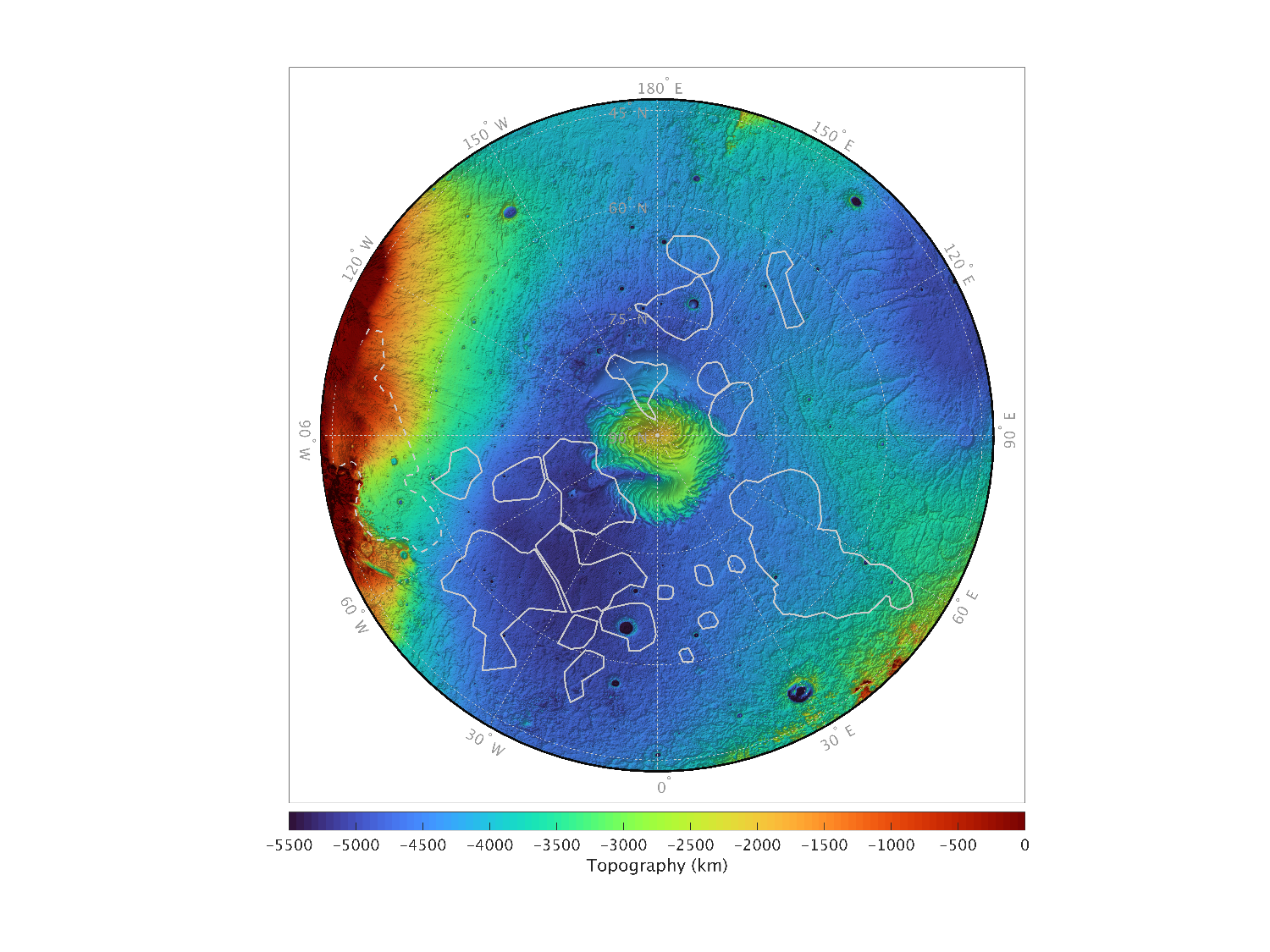Sediments deposited during the time when Mars had a large ocean cover structures whose high densities have been detected in the process of gravity-mapping the planet. Their nature and cause remain a mystery, however. The same mapping process suggests that the largest volcano in the Solar System, Olympus Mons, may be getting larger still, as a result of forces far down within the planet.
With so many satellites now in orbit around Mars we can detect local variations in the Red Planet’s gravity as they pass overhead, based on subtle changes to their speed. Dr Bart Root of Delft University of Technology has presented findings from an analysis of these movements to the Europlanet Science Congress, held in Berlin last week.
Root highlighted the identification of hidden structures on the northern polar plains, where water drained when Mars had it.
“These dense structures could be volcanic in origin or could be compacted material due to ancient impacts. There are around 20 features of varying sizes that we have identified dotted around the area surrounding the north polar cap – one of which resembles the shape of a dog,” Root said in a statement. “There seems to be no trace of them at the surface. However, through gravity data, we have a tantalising glimpse into the older history of the northern hemisphere of Mars.”
The mysterious structures are substantially denser than the locations around them, with a difference of around 300-400 kilograms per cubic meter (19-25 pounds per cubic foot). That puts them 10-13 percent above the average density of the Martian crust, and only slightly below the density of the mantle.
Any of the possible explanations Root offered would change how we see Mars. For example, Root and colleagues write, “If these structures are interpreted as impact craters this would suggest of an older crustal age of the northern hemisphere of Mars than is now considered.”
The high-mass regions of the Martian Polar region outlined. Nothing can be seen on the surface to explain them.
The other major feature Root presented comes from Tharsis Rise, the part of Mars most contrasting with the polar lowlands. Here, giant mountains that dwarf anything on Earth tower over the surrounding land, including Olympus Mons, the highest of all.
The Tharsis area presents a puzzle in the form of a weak gravity region surrounding it. This must be the result of a broad low-density area, but volcanoes themselves are the opposite.
Root and colleagues propose that deep within Mars – more than 1,000 kilometers (621 miles) down or a third of the way to the center – there is a low-density pocket 1,600 kilometers (994 miles) across. The area Root identified is only slightly less dense than what surrounds it – by about 60 kilograms per cubic meter (3.7 pounds per cubic foot) – representing a much smaller deviation than the polar structures, but its area is vastly larger and it is probably 350 kilometers (217 miles) thick. He attributes this to a gigantic lava plume rising upwards and leaving a relative void behind. If so, this plume could not only have created volcanoes more than twice as high as any on Earth, but be continuing to raise them.
Volcanologists have hardly dared to dream Mars is still volcanically active, but there are increasing hints it might be true.
“The NASA InSight mission has given us vital new information about the hard outer layer of Mars. This means we need to rethink how we understand the support for the Olympus Mons volcano and its surroundings,” Root said. “It shows that Mars might still have active movements happening inside it, affecting and possibly making new volcanic features on the surface.”
Root’s talk is part of a quest to build support for a more detailed mapping of Martian gravity using technology like the Gravity Recovery and Interior Laboratory (GRAIL) mission, which found a giant structure under the Lunar South Pole.
The abstract of Root’s talk is here. A talk at the same conference discussed how quantum technologies can be used to improve gravitational mapping of Mars as Root proposed.
The study is undergoing peer review, and a preprint is available on Authorea.com.
Source Link: Hidden Structures Found Beneath Mars’ Ancient Ocean And Largest Mountain
